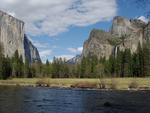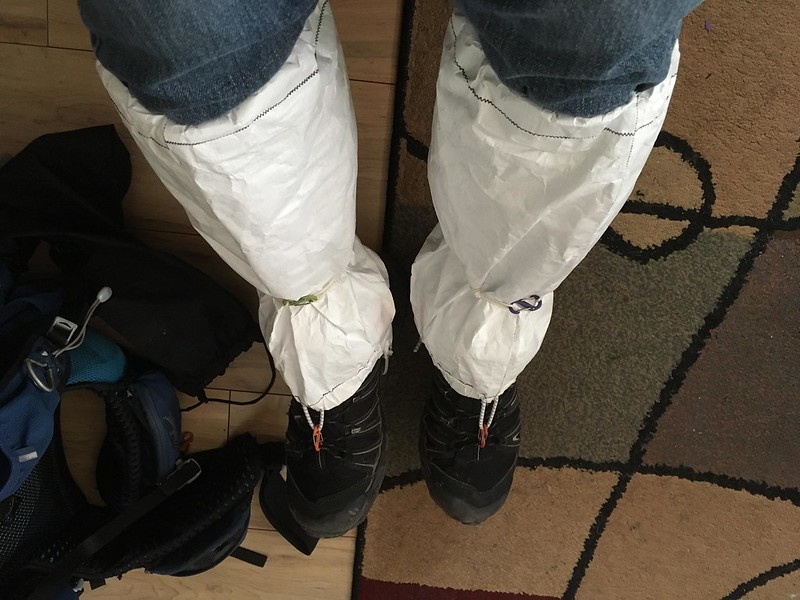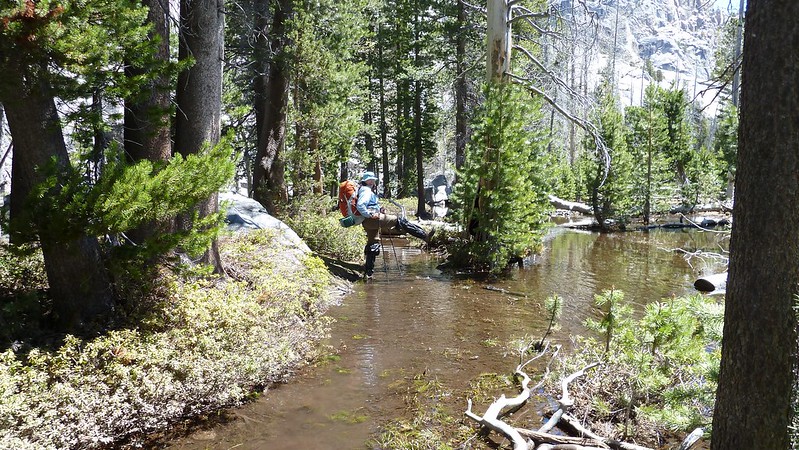There was a short section of trail in Redwood Canyon that the Pink One had not yet completed, so we headed cross-country to our campsite from a few years ago so that he could check off this segment.
Small Hart Meadow had patches of bare ground surrounded by thick pillows of snow.
The granite slabs we had camped on a few years ago had been bone dry in January of 2015, but now were covered with snow.
After a brief break, we followed the trail, under intermittent snow, into the sequoias and the Barton Post Camp area.
Boop! Boop!
We passed by several large specimens along the way.
Boop!
Fortunately, only a few mature sequoias had been felled before the loggers lost interest in Redwood Canyon, so there were very few "big stumps", especially compared to the Big Stump or Converse Grove areas.
Boop!
A bit past Barton Creek we reached the junction with the Redwood Creek trail, and thus another TrailQuest segment was completed.
Boop!
We climbed past numerous trees to the Redwood Saddle parking area, where we stopped for lunch.
Once lunch was finished, we headed out along the Sugarbowl Trail, continuing the "boop the tree" game.
Boop!
We passed by far too many sequoias to have been able to "boop" them all.
Boop! Boop! Boop! Boop! Boop! Boop!
We also passed by--or stepped over--many freshly-fallen sequoia branches, most likely from last Sunday's windy gusts. Many of these "branches" were the size of mature non-sequoia trees.
The trail was a steady climb from Redwood Saddle to our intended campsite above the Sugarbowl, but the trees provided enough distraction.
Boop! Boop! Boop!
The largest sequoia trees in the Redwood Mountain grove are far down the "record trunk volume" list, and most are not particularly huge, superficially resembling their distant coastal cousins more than the giants of Giant Forest.
Most of the sane people in the party gave up about here...
At a few breaks in the grove we were treated to views towards the south, with Dennison Ridge, where we had been last weekend, rising prominently above Ash Peaks Ridge and Milk Ranch Peak.
More and more fallen sequoia branches reaffirmed our decision to camp on an open ridge instead of in the grove.
Boop! Boop! Thud! THUD!
We managed to locate a level and clear enough place, and after some leveling work, we pitched our tent.
From our campsite we could see several places we had been recently as part of the low-elevation SEKI TrailQuest: our campsite on Old Colony Mill Road, Yucca Mountain near North Fork, upper Paradise Creek, the "back" of Homers Nose, and Dennison Ridge.
Closer to us we could see Buena Vista Peak and Big Baldy, which glowed red as the sun finally set for the day.
The nighttime temperatures had been comfortable--even drops of water on the ground cloth in the vestibule had not frozen at night. It became quite warm once the sun hit the tent, and except for the fact we were camped on a foot or two of snow, the morning was warmer than many high-elevation summer mornings.
Before heading back to the car, we wanted to check out the final bit of the grove, including the Sugarbowl group itself.
Boop! Boop! Boop! Boop! Boop! Boop!
We were not really in a hurry to leave the big trees behind.
Boop! (echoes) Boop... boop...
We reached the Sugarbowl itself all to soon. This is a small group of trees, not unlike the House or Senate groups of the Giant Forest, that consists of many similarly-aged sequoias and few other species.
The Sugarbowl don't boop
Past Sugarbowl the trail descends into Redwood Creek. Rather than take this longer route back to the car, we retraced our steps back along Redwood Mountain.
Apparently, Redwood Mountain is where a lot of the research into the role of fire in the lifecycle of sequoias took place. There was ample evidence of recent burns that had killed many of the smaller non-sequoia trees, but had merely charred the outer bark of the more resilient sequoias. (Down closer to Redwood Creek is a section where there is a jungle of 15-20' tall sequoia trees that sprouted after a fire.)
For some reason it seems we had to re-"boop" several of the trees on the way back.
Re-Boop! Re-Boop! Re-Boop! Re-Boop!
Once at Redwood Saddle, we decided to walk the closed road back to our car instead of retracing our steps through the Hart Meadow area.
Walking the road allowed us to spend more time with the large trees that it passes than we normally could driving the road.
One tree near a creek had a large, natural walk-through tunnel.
From inside this tunnel one could see how far up the tree the inner trunk had burned.
From this point we left most of the sequoias behind. The sun was downright hot as we climbed the last few hundred feet to the parking lot, where numerous families were having fun sledding in the snow--a very winter-like way to enjoy a very summer-like day.







